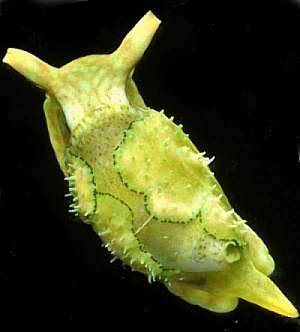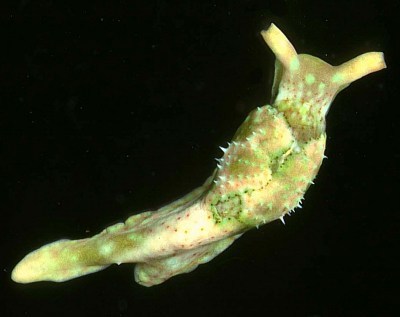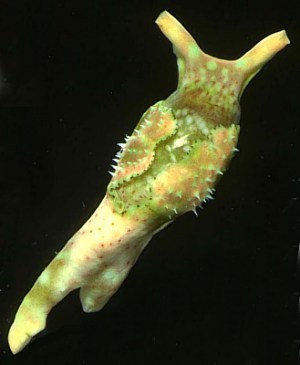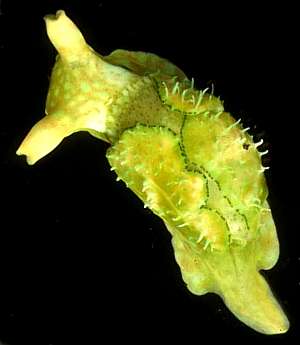

Oxynoe sp. 3
Order: SACOGLOSSA
Superfamily: OXYNOOIDEA
Family: Oxynoidae
PHOTO
Heron Island, Great Barrier Reef, Queensland, Australia. November 1999. 14 mm long. Photo: Julie Marshall.
See message below.
Authorship detailsRudman, W.B., 2000 (August 2) Oxynoe sp. 3 [In] Sea Slug Forum. Australian Museum, Sydney. Available from http://www.seaslugforum.net/find/oxynsp3
Related messages
Oxynoe sp. with two tails
February 7, 2001
From: Julie Marshall


Dear Bill,
Last year I sent you some photos of an Oxynoe with a short tail which you called Oxynoe sp. 3. In November 2000 I found another specimen of the same species at Heron Island [Great Barrier Reef] but this animal had a faulty regrowth resulting in two "tails" – a short one like in the original specimen and a larger tail growing above it. This animal was 16 mm long.
Best wishes
Julie Marshall
j.marshall@latrobe.edu.au
Marshall, J., 2001 (Feb 7) Oxynoe sp. with two tails. [Message in] Sea Slug Forum. Australian Museum, Sydney. Available from http://www.seaslugforum.net/find/3663Thanks Julie,
It looks like this one has a regrown tail which suggests there is something at Heron Island which is rather partial to a meal of Oxynoe. As Cynthia says in a message today, we don't know much about what eats opisthobranchs.
Bill Rudman
Oxynoe sp. from Heron Island
August 6, 2000
From: Julie Marshall


Dear Bill,
Attached are two photos of an Oxynoe species found in November 1999 on Caulerpa at the reef crest on the north side of Heron Island [Great Barrier Reef, Queensland, Australia] under a dead coral slab. It was 14 mm in size and had a brownish green mantle with a speckling of brown dots which show through the transparent shell. The parapodia have numerous fine green papillae and there is a line of black dots on the edges of the parapodial borders. There are also green patches on the head and rhinophores and on the lower parts of the parapodia. This animal lacked the long tail of the usual Oxynoe but the short tail could have been newly regenerated.
Best wishes,
Julie Marshall
j.marshall@latrobe.edu.au
Marshall, J., 2000 (Aug 6) Oxynoe sp. from Heron Island. [Message in] Sea Slug Forum. Australian Museum, Sydney. Available from http://www.seaslugforum.net/find/2820Thanks Julie,
The papillate parapodia and the short 'tail' are certainly unusual. It certainly looks like it is regrowing from a stump, and Oxynoe viridis can break off its 'tail' [see autotomy page].
It will be interesting to hear what our sacoglossan experts think about its identity.
Best wishes,
Bill Rudman.
